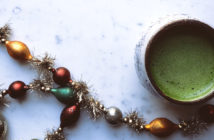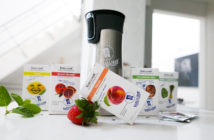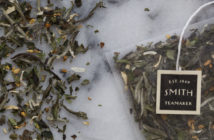The Daily Tea recently had the opportunity to chat with Maria Uspenski, founder and CEO of The Tea Spot. The Tea Spot is a leading producer of handcrafted whole leaf teas and creator of Steepware – the housewares tools that make loose tea easy.
The company’s vision to modernize the loose leaf tea experience has held steadfast since the for-profit philanthropic company was founded by Uspenski in 2004, a cancer survivor drawn to the health benefits of leaf tea during her recovery.
Uspenski is also the author of Cancer Hates Tea, and she was recognized as the “Top Tea Health Advocate” at the 2017 World Tea Conference + Expo. She is often featured as a social entrepreneur and certified tea and fitness nutrition expert, in addition, to be a sought-after speaker on tea and wellness.
Uspenski’s message is simple and powerful: tea in its freshest form renders premium flavor, unmatched health benefits, and is eco-friendly. The company’s model of social entrepreneurship incorporates its mission to foster health and wellness through loose leaf tea with its 10% Pledge. Ten percent of every sale made is donated in-kind to cancer and community wellness programs. The Tea Spot is a Boulder, Colorado-based woman-owned and operated business.
***
What were some of your favorite moments of 2019?
As I scroll back through the photos on my phone, I feel almost overwhelmed at all the beautiful tea moments I got to experience in 2019.
I invited my executive team at The Tea Spot to go do Ride the Rockies, a challenging six-day 400+ mile bike ride with more than 28,000 feet of climbing – all fueled by tea! My colleague Jessica Kochik, CMO at The Tea Spot, accepted – I’ve never seen her shy away from any challenge – and she joined me and my brother Alex on this journey. She absolutely nailed it (I struggled at times!). We rode every mile of the ride and made some fantastic memories. Our home state of Colorado is so extraordinarily beautiful, and when you spend six full days experiencing its epic views and climbs up close and personal on a bike, its beauty touches you even more profoundly. And yes, we stayed fueled by tea, as the hashtag on our branded “teasy riders” kit attests. Our favorite morning natural electrolyte concoction was ice water with half a lemon and a teaspoon of matcha, then shaken to mix.
Taking three members of our team to a wild, remote area of Yunnan Province in Southwestern China was also a most memorable highlight. Connecting my tea sourcing and production colleagues with our tea while it’s still on the tree, and having them experience the masterful plucking and production methods, which use no electricity in any point of the process, and drinking our tea immediately after it was a finished tea in the wild tea forest… it really was unforgettable. Probably my favorite moment of this trip was when we found “our tree.” Our Wild Harvest Green Pu’erh is what we source from this tea forest. Some of the trees are more recently planted, maybe 50 years old, but others are much older, some being several hundred years old. While out plucking tea leaves under the gorgeous Yunnan sunshine, one of these older gnarly trees seemed to beckon and invite us in to catch some shade. We each sat under her for an extended period, silently. She literally embraced us. The boss noticed our attraction to this tree and said we could keep that tree and her leaves for our own exclusive production, and we were all excited to be launching some Pu’erh cakes later this year which are made with this tree’s leaves. But the most memorable moment on that trip to Yunnan was the pickup basketball game for which the whole tea village showed up. Even without any verbal communication between us and the locals, it was a moment of intense understanding of shared appreciation for the game.
The final highlight for last year was seeing our new over-wrapped tea sachets getting accolades in quality restaurant and cafe settings. We had started producing these on a Fuso machine, which we’d procured in the end of 2018, and we’re thrilled that our efforts in foodservice are being well received. The green Pu’erh I mentioned earlier, as well as some delicate green teas from Japan and China, and an exquisite Phoenix Mountain oolong are all part of our foodservice collection. It’s a real thrill for me to see the tea material and the careful work of the tea masters we have make first-hand connections with elevating the premium tea experience. It’s also rewarding to see our functional teas, signature blends, commercial iced teas, and some new herbal and decaf green teas, which we handcraft in-house, getting some fan traction in this sector.
What are you looking forward to this year – 2020?
Oy! So much change… expansion mostly. We’re getting a 2nd Fuso machine in June, have entered into some significant new partnerships, and will be launching a few key new products, working to keep on point with current trends in the industry. We will soon have an adaptogenic herbal chai, we’re developing delicious teas for new OEM customers, a new cold brew tea bottle. With any luck, I will also be able to set aside time for writing a new book on tea education, with some very exciting tea industry collaborators!
What tea trends do you see rising? Anything specific to The Tea Spot?
Functional, adaptogenic and CBD teas. Everyone wants to feel more centered in this hectic time!
I’d like to know more about where The Tea Spot sources their tea. Can you talk a little about that? Why you chose where you sourced, etc.
Over the past 15 years, we have developed close relationships with our producers as well as key distributors, so we are always connected to the product quality, livelihood, and well-being of our tea farmers. These relationships have also allowed us to be able to tweak the production of certain raw tea materials to work well for our clientele’s palates and our signature blends. As tea is a global beverage, we are all interconnected – from the garden operations to the processor, the certifiers, the supply chain, our wholesalers, and our direct customers. We are strong believers that the legacy of the leaf, as well as the cup that you drink it from, need to uphold best practices in both quality of product and the social integrity behind it. We are thankful for the relationships of trust that have been built over the years with suppliers in China, Japan, India, and Sri Lanka – where spreading the love of the leaf is our shared goal.
Where would you like to see the tea industry in the next 5, 10 years?
For us at The Tea Spot, our mission of promoting wellness through tea will have moved forward successfully if more people are making tea a part of their everyday. And in a perfect world, foodservice will have a plethora of great tea options, and we will all be able to taste wonderful new teas in North America.
Let’s discuss your involvement with the World Tea Conference + Expo? I see you’re a premium sponsor this year. What are you looking forward to at the expo this year (especially since it’s closer to The Tea Spot’s home!)
We are so excited to have the World Tea Conference + Expo coming to our backyard! In addition to teaching the marketing session for New Business Bootcamp, my team and I will be doing some presentations and cupping of CBD teas at this year’s program. Since the conference will be in Denver this year, we’re excited to get our whole team involved. Attendees will be able to speak with our in-house R&D team or tea crafters at our booth, as we blend and pack all of our whole leaf teas and sachets here in Colorado.
What advice would you like to pass on to people as the new year unravels – as far as healthier lifestyle changes inspired by tea?
Tea, every day. In my book, Cancer Hates Tea, I advocate for five (8 oz) cups a day. It’s a lot easier than one might expect. Also, I’d advise that people take a closer look at adaptogens, to help find a daily moment of peace with their tea. Camellia sinensis is also an adaptogen, by the way.
What are some of your favorite styles of tea and why? What do you drink and when?
My husband and I begin every day with either our Wild Harvest Green Pu’erh (shan pu’erh) or a Japanese green tea, like our Japanese Orchid Sencha. I love collecting different senchas (and amazing ceramic teawares!) in Japan. It’s great to start out the mornings with something cleansing and refreshing. I also totally love the aromas of those teas. On weekends, we might go with a black (shu) pu’erh, but I can’t really say why that’s more of a weekend ritual. Later I often sip on a cold-brewed oolong tea at work. I use our larger tumbler, the “Everest”). I also drink whatever teas we have to cup that day because it’s my job. When I stay at home, I always sneak away for a few hours to my 9 x 12 feet teahouse, where I’ll usually indulge in a Shu pu’erh, Da Hong Pao, or a phoenix mountain oolong – either “8 Immortals” or Duck Shit oolong! And sometimes, I climb the hills behind my house with a tumbler of pu’erh to decompress. In the evenings, I do enjoy a warm herbal, either a hibiscus blend, like our Flat Belly Hibiscus Cucumber, or our anti-inflammatory Turmeric Tonic.
To learn more about The Tea Spot and its array of tea and teaware offerings, visit https://www.theteaspot.com.



